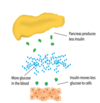Optional module - Diabetes and Obesity Flashcards
When are in-uteros at risk of obesity?
Babies that are born smaller than usual
Have + risk of obesity and CVD later in life
When are children at risk of adult obesity?
If overweight under 5 years old
+ risk if one or both parents are overweight
When are adolescence at risk of adult obesity?
If overweight when adolescence
When are adult females at risk of obesity?
- Pregnancy
- Oral combined pill
- Menopause
How does male weight change overtime?
- Progressive increase over the decades until 6th decade
- Progressive reduction in energy expenditure as age
- Stabilises between 55-64 then slowly declines
What other factors affect weight?
- Sleep deprivation
- Smoking cessation (4-5kg on average)
- Drugs:
- Antidepressants
- Antiepileptic drugs
- Diabetes drugs
- Beta blockers
- Glucocorticoids
What illnesses can affect weight?
- Hypothyroidism (low energy expenditure)
- Polycystic ovarian syndrome (50% obesity rates)
- Cushing’s syndrome (excess endogenous glucocorticoid)
- Hypothalamic obesity (severe uncontrolled increase in appetite)
What are general potentiual causes of obesity?
- Excess calorie intake
- Genetics, intrauterine environment and post-brith environment
- Ethnic differences
- Socioeconomic differences
What are problems with melanocortin-4 receptor deficiency?
Associated with early onset obesity and taller than average height
What are problems with POMC gene defects?
- Infant adrenal crisis
- Early onset obesity from hyperphagia caused by ‘alpha’ MSH deficiency
What is the function of leptin?
What are problems with leptin deficiency?
Informs brain of extent of fat stores
Deficiency = hyperphagia and obesity
What is Berardinelli Seip syndrome?
Leptin deficiency
Leads to no fat storage in body
What is Prader Willi syndrome?
- Genetic abnormalities on long arm of chromosome 15
- Neonatal hypotonia and cryptorchidism
- Hypothalamic dysfunction:
- Hunger with lack of satiety
- Obesity
- Low sex hormones and growth hormone
- Cognitive and behavioural challenges
What is Bardet Beidl syndrome?
- Autosomal recessivie disorder
- Obesity
- Intellectual disability
- Small male testes
- Retinal dystrophy
- Polydactyly
Where is the worst place to store fat and why?
What is the waist-to-hip ratio for this?
In the abdominal region
- Associated with + risk of CVD
- Apple shaped figure
Women = >0.85
Men = >1
What is increased visceral fat associated with?
What does comparision of normal and T2D CT look like?
Metabolic syndrome:
- hypertension risk
- hyperlipiodaemia risk
- impaired glucose tolerence progressing to type 2 diabetes risk
- CVD

Why is visceral fat a problem?

What are the main associated health risks with obesity?
- •Diabetes
- •Hyperlipidaemia
- •Hypertension
- •CVD
- •Heart failure
- •Atrial fibrillation
- •Stroke disease
- •Venous thrombosis
What are the musculoskeletal risks with obesity?
- Osteoarthritis
- Gout
What are the gastrointestinal risks with obesity?
- Hepatic disease
- NASH
- Cirrhosis
- Gall stones (Cholelithiasis)
What are the renal risks with obesity?
- Chronic kidney disease
- Renal stones
- Urinary incontinence
What are respiratory risks with obesity?
Sleep apnoea
What are the 2 main drugs used for weught loss in EU?
Orlistat - 60-120mg / day - Oral - intestinal lipase inhibitor, reducing fat absorption by 30%
Liraglutide - 3mg / day - SC injection - GLP-1 agonist, reducing hunger and delaying gastric emptying
What are the 3 types of surgery fpr weight loss?
Gastric bypass
Gastric banding
Duodenal bypass

What should glucose levels be and what are the dangers when out of this range?
- Normal circulating [glucose] is 4-5 mM.
- [glucose] below ~4 mM causes problems:
- [glucose] < 1-2 mM and brain cannot sustain activity
- brain is obligate glucose utilising tissue
•[glucose] above 7-8 mM is also dangerous:
- glycation of proteins
- peripheral and CNS neuron damage
What are the 3 main sources of glucose?
- Glycogenolysis
- Gluconeogenesis
- Diet
What are the properties of glucose uptake?
- Mediated by series of glucose transporters
- Glucose transporters = proteins in cell surface
- Channels form which allow transport across membrane
What is the main GLUT and why is it different from the others?
GLUT 4
Is the only insulin-dependent one
1-5 = don’t require ATP
What is the purpose of kinases in cells during glucose sensing?
Remove GLUT2 transporter from cell once glucose is in the cell

What is the order of events of glucose sensing in the brain of neonates and adults?

What 2 things directly cause insulin release in pancreatic ‘beta’-cells?
+ calcium ion concentration
G coupled protein binding

What are the properties of the insulin receptor?
- Is a tetramer (has 4 subunits)
- Beta subunits are in the membrane
- Alpha subunits are above membrane
- Subunits are attached by disulphide bridges
- Kinase domains phosphorylase other proteins

What are the early events of insulin signalling?
- Insulin binds as a monomer
- 2 identical binding sites per receptor
- Receptors are activated by conformational change from insulin binding
- ‘Beta’-subunit tyrosine kinase domains trans-phosphorylate one-another

What are the second early events of insulin signalling?
- Phosphorylated insulin receptor cytoplasmic domain acts as docking site for various IR effectors
- IR effects contain specific phosphotyrosine (pY) binding domains
- PTB and SH2 domains bind pY motifs
- IR tyrosine phosphorylates IRS, Shc and SH2 proteins










